Introduction: A Name in the Dynasty
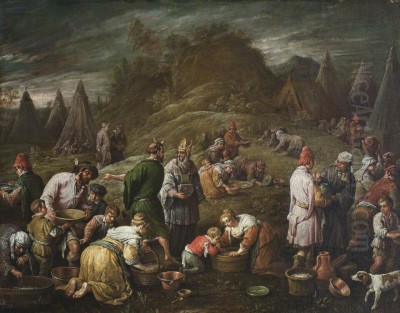
Francesco Bassano the Younger, born Francesco Giambattista da Ponte on January 26, 1549, was a significant painter of the Italian Renaissance, deeply embedded within the Venetian School. As the eldest son of the renowned artist Jacopo Bassano, Francesco inherited not only a name synonymous with a particular style of painting but also the mantle of leadership within one of the most prolific artistic workshops of the era. His life, marked by both considerable artistic output and profound personal tragedy, offers a compelling glimpse into the world of late 16th-century Venetian art. Known interchangeably as Francesco Bassano the Younger or Francesco da Ponte the Younger, he navigated the complex currents of family tradition, artistic innovation, and the demanding patronage system of Venice, leaving behind a body of work characterized by vibrant genre scenes, dramatic religious narratives, and a distinctive use of light and shadow, before his untimely death on July 4, 1592.
The Bassano Workshop: A Family Affair
The Da Ponte family, who took their moniker "Bassano" from their native town of Bassano del Grappa near Venice, established a formidable artistic dynasty. The workshop was founded by Francesco the Elder (c. 1475–1539), Francesco the Younger's grandfather. However, it was under the leadership of Jacopo Bassano (c. 1510–1592), Francesco the Younger's father, that the workshop achieved widespread fame and influence. Jacopo developed a distinctive style blending rustic naturalism with sophisticated Venetian colour and Mannerist compositional devices.
Francesco the Younger received his primary artistic training within this bustling family enterprise. He learned alongside his younger brothers, Giambattista da Ponte (1553–1613), Leandro Bassano (1557–1622), and Gerolamo Bassano (1566–1621), all of whom became accomplished painters in their own right. The Bassano workshop operated on a collaborative model, particularly for larger commissions or popular compositions that were replicated with variations for the market. This often makes definitive attribution of specific works to a single hand challenging, especially during the period when Francesco worked closely under his father's supervision. His early works inevitably show a strong adherence to Jacopo's style and techniques.
Developing a Style: Rustic Scenes and Religious Drama
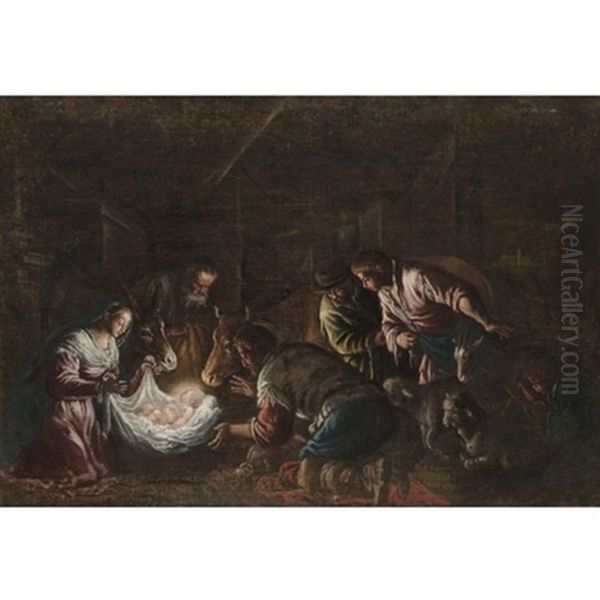
Francesco Bassano the Younger largely continued the stylistic traditions established by his father. His work is celebrated for its lively depiction of rural life, bustling market scenes, and detailed kitchen interiors, often populated with peasants, merchants, and an abundance of animals and still-life elements. These genre paintings, while seemingly secular, frequently served as settings for biblical narratives, grounding sacred stories in the familiar world of contemporary Veneto. This approach made religious themes more accessible and relatable to viewers.
His paintings are characterized by rich, often earthy colours, and a dynamic application of paint. He became particularly adept at depicting notte, or night scenes, utilizing dramatic chiaroscuro – strong contrasts between light and dark – to heighten the emotional intensity and focus the viewer's attention. This technique was employed effectively in religious subjects like the Adoration of the Shepherds or Christ in the Garden of Gethsemane, where flickering candlelight or divine radiance pierces the surrounding gloom. While heavily influenced by Jacopo, some art historians suggest Francesco's later independent works occasionally display a slightly tighter handling or a different atmospheric quality compared to his father's looser brushwork.
The influence of major Venetian masters like Titian (Tiziano Vecellio) and particularly Tintoretto (Jacopo Robusti) can also be discerned in Francesco's work, especially in the energetic compositions and dramatic lighting effects. Though trained primarily by his father, the artistic environment of Venice, dominated by these giants and the decorative richness of Paolo Veronese, inevitably shaped his artistic vision. He absorbed the Venetian emphasis on colourito (colour and painterly application) over disegno (drawing and design), characteristic of the Central Italian schools.
Representative Works and Popular Themes
Francesco Bassano the Younger's oeuvre covers a range of subjects, with certain themes recurring frequently due to their popularity with patrons and the workshop's efficient production methods. Biblical stories set in rustic environments were a hallmark. Multiple versions of the Adoration of the Shepherds and the Adoration of the Magi exist, showcasing his skill in rendering animals, varied human types, and atmospheric lighting.
The Purification of the Temple (also known as Christ Driving the Money Changers from the Temple) was another subject he revisited. These compositions allowed for dynamic action and the inclusion of numerous figures and animals within an architectural setting. While one source snippet suggested a connection to a Titian portrait exchange, this is not widely corroborated; rather, the theme itself was popular, and the Bassano workshop produced several versions.
Other significant works and themes include:
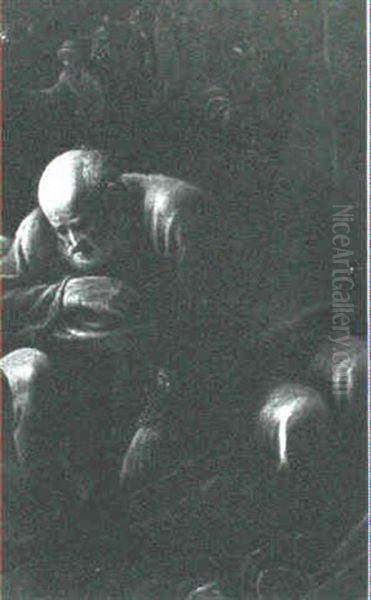
Allegories of the Seasons (e.g., Autumn, Winter): These often took the form of bustling scenes filled with figures engaged in seasonal activities, surrounded by appropriate produce and animals.
Allegories of the Elements (e.g., The Element of Fire, depicting Vulcan's forge; The Element of Air): These allowed for imaginative compositions blending mythology and genre details.
The Last Supper: Often depicted in a humble, rustic interior, emphasizing the humanity of the scene.
Christ in the House of Martha and Mary: Another opportunity to combine a biblical narrative with a detailed kitchen or domestic interior scene.
Market Scenes: Vibrant depictions of commerce and daily life.
His skill in rendering animals – dogs, sheep, cattle, poultry – was exceptional and a key feature of the Bassano brand. Similarly, his detailed portrayal of copper pots, baskets of fruit, vegetables, and game contributed significantly to the development of still life painting as an independent genre, even though in his work these elements usually remained part of a larger narrative or genre scene.
The Venetian Workshop and Major Commissions
Around 1579, Francesco moved with his father Jacopo to Venice, the vibrant heart of the Republic's artistic and commercial life. This move was prompted, in part, by the need to fulfill major public commissions, most notably for the Doge's Palace, which had suffered a devastating fire in 1577 that destroyed works by artists like Gentile da Fabriano, Pisanello, Alvise Vivarini, Gentile Bellini, Giovanni Bellini, Carpaccio, Titian, and Tintoretto.
The Bassano workshop, including Francesco, contributed significantly to the redecoration efforts. They worked alongside other prominent artists of the day, such as Tintoretto, Paolo Veronese, and Palma il Giovane (Jacopo Palma the Younger), creating large historical and allegorical canvases for the palace's grand halls, such as the Sala del Maggior Consiglio (Hall of the Great Council) and the Sala dello Scrutinio (Voting Hall). Francesco often worked from his father's designs for these large-scale projects, executing them with the help of the workshop assistants. This period cemented the Bassano reputation within the competitive Venetian art market. Francesco effectively managed the Venetian branch of the family workshop during these years.
Contemporaries in the Venetian Milieu
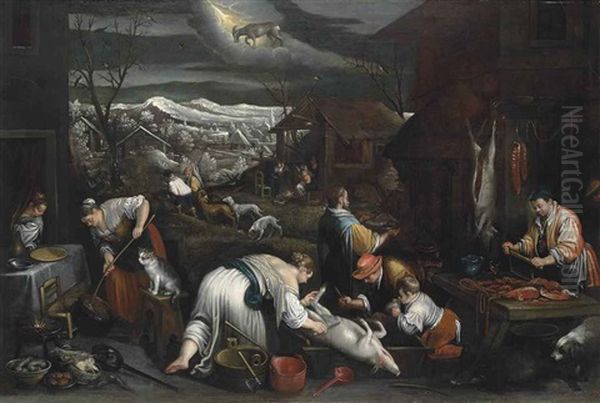
Francesco Bassano the Younger operated within one of the richest artistic environments in Renaissance Europe. Venice in the late 16th century was a crucible of talent and innovation. His most immediate artistic circle consisted of his family: his father Jacopo Bassano, the guiding force, and his brothers Leandro Bassano, Giambattista Bassano, and Gerolamo Bassano. Leandro, in particular, achieved considerable independent success, eventually being knighted.
Beyond the family, the towering figures of the older generation, Titian, Tintoretto, and Paolo Veronese, defined the artistic landscape. While Titian died in 1576, his influence remained pervasive. Tintoretto and Veronese were active and highly competitive rivals during Francesco's prime working years. Francesco and the Bassano workshop often competed directly with them and their followers for commissions.
Other notable contemporaries included Palma il Giovane, who became a dominant figure in Venetian painting after the deaths of Tintoretto and Veronese, and Domenico Tintoretto, Jacopo Tintoretto's son and follower. The legacy of earlier masters like Lorenzo Lotto and Bonifacio Veronese (Bonifacio de' Pitati), Jacopo Bassano's teacher, also formed part of the artistic heritage Francesco inherited. Sculptors like Alessandro Vittoria were also key figures in the Venetian cultural scene, contributing to the integrated decoration of churches and palaces. While direct, documented collaborations outside the family workshop and the Doge's Palace projects are scarce, Francesco was undoubtedly aware of and responsive to the work of these and other artists active in Venice.
A Life Cut Short: Tragedy and Mental Struggle
Despite his artistic productivity and role within the successful family business, Francesco Bassano the Younger's life ended tragically. Historical sources, notably the biographer Carlo Ridolfi writing in the 17th century, describe him as suffering from "melancholy," what would likely be diagnosed today as severe depression. This condition may have been exacerbated by the pressures of managing the workshop, meeting commission deadlines, and perhaps a fear of persecution or inadequacy. Some accounts also mention physical ailments, possibly tuberculosis, contributing to his distress.
In 1592, his father Jacopo Bassano died. This loss seems to have profoundly affected Francesco. Within a few months, overwhelmed by grief and his ongoing mental struggles, Francesco died by suicide, jumping from a window of their Venetian home. He was only 43 years old. His death was a significant blow to the Bassano workshop, with leadership passing to his brother Leandro, who continued the family tradition successfully for many more years.
Legacy: Enduring Style and Influence
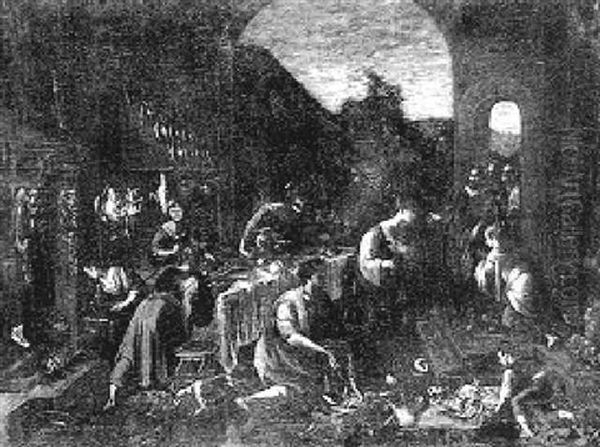
Francesco Bassano the Younger played a crucial role in consolidating and disseminating the Bassano style. While often working in the shadow of his more innovative father, he was a highly skilled painter who excelled in the detailed, naturalistic depiction of genre and religious scenes that became the family's trademark. His mastery of dramatic lighting, particularly in night scenes, added a distinct emotional register to his work.
Through the prolific output of the workshop, which he helped manage and lead, Francesco contributed significantly to the popularity of Bassano paintings across Italy and Europe. These works, with their blend of rustic charm, religious sentiment, and painterly vibrancy, appealed to a wide range of patrons and collectors. His tragic end underscores the immense pressures faced by artists in the highly competitive Renaissance art world, even within the supportive structure of a family workshop. Though attributions can sometimes be complex due to the collaborative nature of the Bassano enterprise, Francesco the Younger remains recognized as a key figure in the later Venetian Renaissance, a talented artist whose work continues to engage viewers with its lively detail and poignant humanity. His paintings are held in major museums worldwide, testament to the enduring appeal of the Bassano vision.